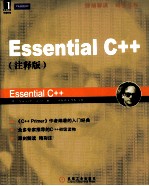

Essential C++注释版PDF电子书下载
- 电子书积分:11 积分如何计算积分?
- 作 者:(美)斯坦利著
- 出 版 社:北京:机械工业出版社
- 出版年份:2010
- ISBN:9787111312215
- 页数:290 页
Chapter 1:Basic C++ Programming 1
1.1:How to Write a C++ Program 1
1.2:Defining and Initializing a Data Object 7
1.3:Writing Expressions 10
1.4:Writing Conditional and Loop Statements 15
1.5:How to UseArrays and Vectors 22
1.6:Pointers Allow for Flexibility 26
1.7:Writing and Reading Files 30
Chapter 2:Procedural Programming 35
2.1:How to Write a Function 35
2.2:Invoking a Function 41
2.3:Providing Default Parameter Values 50
2.4:Using Local Static Objects 53
2.5:Declaring a Function Inline 55
2.6:Providing Overloaded Functions 56
2.7:Defining and Using Template Functions 58
2.8:Pointers to FunctionsAdd Flexiblity 60
2.9:Setting Up a Header File 63
Chapter 3:Generic Programming 67
3.1:The Arithrnetic of Pointers 68
3.2:Making Sense of Iterators 73
3.3:Operations Common to All Containers 76
3.4:Using the Sequential Containers 77
3.5:Using the Generic Algorithms 81
3.6:How to Design a Generic Algorithm 83
3.7:Using a Map 90
3.8:Using a Set 91
3.9:How to Use Iterator Inserters 93
3.10:Using the iostream Iterators 95
Chapter 4:Object-Based Programming 99
4.1:How to Implement a Class 100
4.2:What Are Class Constructors and the Class Destructor? 104
4.3:What Are mutable and const? 109
4.4:What Is the this Pointer? 113
4.5:Static Class Members 115
4.6:Building an Iterator Class 118
4.7:Collaboration Sometimes Requires Friendship 123
4.8:Implementing a Copy Assignment Operator 125
4.9:Implementing a Function Object 126
4.10:Providing Class Instances of the iostrearn Operators 128
4.11:Pointers to Class Member Functions 130
Chapter 5:Object-Oriented Programming 135
5.1:Object-Oriented Programming Concepts 135
5.2:ATour of Object-Oriented Programming 138
5.3:Polymorphism without Inheritance 142
5.4:Defining an Abstract Base Class 145
5.5:Defining a Derived Class 148
5.6:Using an Inheritance Hierarchy 155
5.7:How Abstract Should a Base Class Be? 157
5.8:Initialization,Destruction,and Copy 158
5.9:Defining a Derived Class Virtual Function 160
5.10:Run-Time Type Identification 164
Chapter 6:Programming with Templates 167
6.1:Parameterized Types 169
6.2:The Template Class Definition 171
6.3:Handling Template Type Parameters 172
6.4:Implementing the Template Class 174
6.5:AFunction Template Output Operator 180
6.6:Constant Expressions and Default Parameters 181
6.7:Template Parameters as Strategy 185
6.8:Member Template Functions 187
Chapter 7:Exception Handling 191
7.1:Throwing an Exception 191
7.2:Catching an Exception 193
7.3:Trying for an Exception 194
7.4:Local Resource Management 198
7.5:The Standard Exceptions 200
Appendix A:Exercise Solutions 205
Appendix B:Generic Algorithms Handbook 255
Index 271
注释 277
- 《战国策注释 下》何建章注释 2019
- 《战国策注释 上》何建章注释 2019
- 《钢琴室内乐作品精选及注释 古典主义时期》曹慧编著 2018
- 《王琦《辑注》注释研究》(中国)李红霞 2019
- 《战国策注释 中》何建章 2019
- 《世界学术经典系列 历史的观念 导读注释版》(英国)科林伍德,张旭,肖志兵 2019
- 《中华人民共和国保险法典 注释法典 14》国务院法制办公室编 2018
- 《章太炎政论选集 注释本》章炳麟著 1981
- 《海顿16首钢琴奏鸣曲选集 注释版》陈学元编注 2017
- 《篆刻学类要注释》劳笃文纂录;李毅峰注释 2019
- 《指向核心素养 北京十一学校名师教学设计 英语 七年级 上 配人教版》周志英总主编 2019
- 《北京生态环境保护》《北京环境保护丛书》编委会编著 2018
- 《高等教育双机械基础课程系列教材 高等学校教材 机械设计课程设计手册 第5版》吴宗泽,罗圣国,高志,李威 2018
- 《指向核心素养 北京十一学校名师教学设计 英语 九年级 上 配人教版》周志英总主编 2019
- 《高等院校旅游专业系列教材 旅游企业岗位培训系列教材 新编北京导游英语》杨昆,鄢莉,谭明华 2019
- 《中国十大出版家》王震,贺越明著 1991
- 《近代民营出版机构的英语函授教育 以“商务、中华、开明”函授学校为个案 1915年-1946年版》丁伟 2017
- 《新工业时代 世界级工业家张毓强和他的“新石头记”》秦朔 2019
- 《智能制造高技能人才培养规划丛书 ABB工业机器人虚拟仿真教程》(中国)工控帮教研组 2019
- 《AutoCAD机械设计实例精解 2019中文版》北京兆迪科技有限公司编著 2019
